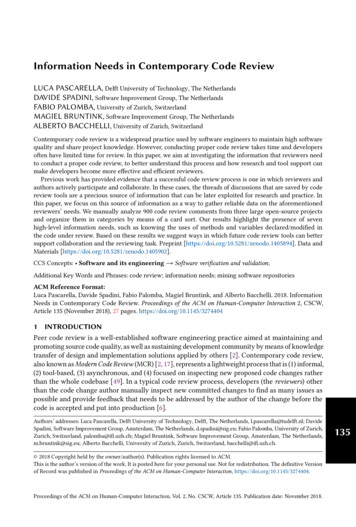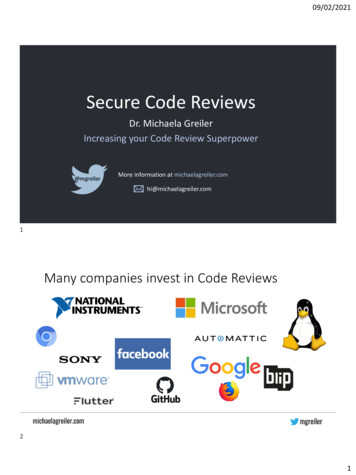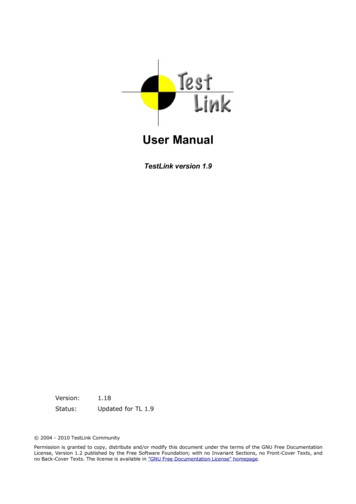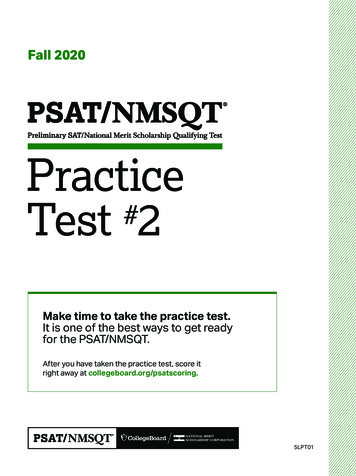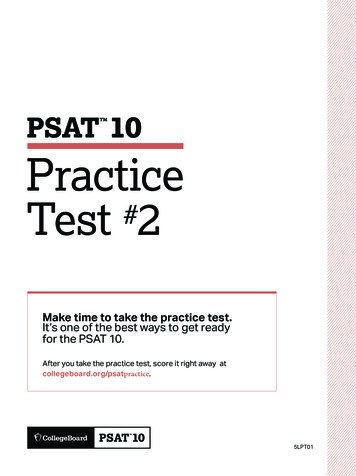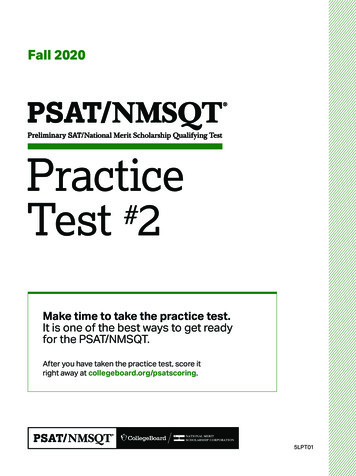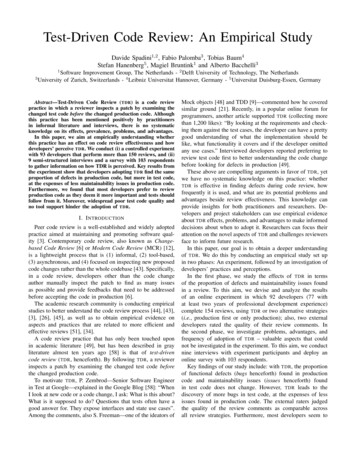
Transcription
Test-Driven Code Review: An Empirical StudyDavide Spadini1,2 , Fabio Palomba3 , Tobias Baum4Stefan Hanenberg5 , Magiel Bruntink1 and Alberto Bacchelli313Software Improvement Group, The Netherlands - 2 Delft University of Technology, The NetherlandsUniversity of Zurich, Switzerlands - 4 Leibniz Universitat Hannover, Germany - 5 Universitat Duisburg-Essen, GermanyAbstract—Test-Driven Code Review (TDR) is a code reviewpractice in which a reviewer inspects a patch by examining thechanged test code before the changed production code. Althoughthis practice has been mentioned positively by practitionersin informal literature and interviews, there is no systematicknowledge on its effects, prevalence, problems, and advantages.In this paper, we aim at empirically understanding whetherthis practice has an effect on code review effectiveness and howdevelopers’ perceive TDR. We conduct (i) a controlled experimentwith 93 developers that perform more than 150 reviews, and (ii)9 semi-structured interviews and a survey with 103 respondentsto gather information on how TDR is perceived. Key results fromthe experiment show that developers adopting TDR find the sameproportion of defects in production code, but more in test code,at the expenses of less maintainability issues in production code.Furthermore, we found that most developers prefer to reviewproduction code as they deem it more important and tests shouldfollow from it. Moreover, widespread poor test code quality andno tool support hinder the adoption of TDR.I. I NTRODUCTIONPeer code review is a well-established and widely adoptedpractice aimed at maintaining and promoting software quality [3]. Contemporary code review, also known as Changebased Code Review [6] or Modern Code Review (MCR) [12],is a lightweight process that is (1) informal, (2) tool-based,(3) asynchronous, and (4) focused on inspecting new proposedcode changes rather than the whole codebase [43]. Specifically,in a code review, developers other than the code changeauthor manually inspect the patch to find as many issuesas possible and provide feedbacks that need to be addressedbefore accepting the code in production [6].The academic research community is conducting empiricalstudies to better understand the code review process [44], [43],[3], [26], [45], as well as to obtain empirical evidence onaspects and practices that are related to more efficient andeffective reviews [51], [34].A code review practice that has only been touched uponin academic literature [49], but has been described in grayliterature almost ten years ago [58] is that of test-drivencode review (TDR, henceforth). By following TDR, a reviewerinspects a patch by examining the changed test code beforethe changed production code.To motivate TDR, P. Zembrod—Senior Software Engineerin Test at Google—explained in the Google Blog [58]: “WhenI look at new code or a code change, I ask: What is this about?What is it supposed to do? Questions that tests often have agood answer for. They expose interfaces and state use cases”.Among the comments, also S. Freeman—one of the ideators ofMock objects [48] and TDD [9]—commented how he coveredsimilar ground [21]. Recently, in a popular online forum forprogrammers, another article supported TDR (collecting morethan 1,200 likes): “By looking at the requirements and checking them against the test cases, the developer can have a prettygood understanding of what the implementation should belike, what functionality it covers and if the developer omittedany use cases.” Interviewed developers reported preferring toreview test code first to better understanding the code changebefore looking for defects in production [49].These above are compelling arguments in favor of TDR, yetwe have no systematic knowledge on this practice: whetherTDR is effective in finding defects during code review, howfrequently it is used, and what are its potential problems andadvantages beside review effectiveness. This knowledge canprovide insights for both practitioners and researchers. Developers and project stakeholders can use empirical evidenceabout TDR effects, problems, and advantages to make informeddecisions about when to adopt it. Researchers can focus theirattention on the novel aspects of TDR and challenges reviewersface to inform future research.In this paper, our goal is to obtain a deeper understandingof TDR. We do this by conducting an empirical study set upin two phases: An experiment, followed by an investigation ofdevelopers’ practices and perceptions.In the first phase, we study the effects of TDR in termsof the proportion of defects and maintainability issues foundin a review. To this aim, we devise and analyze the resultsof an online experiment in which 92 developers (77 withat least two years of professional development experience)complete 154 reviews, using TDR or two alternative strategies(i.e., production first or only production); also, two externaldevelopers rated the quality of their review comments. Inthe second phase, we investigate problems, advantages, andfrequency of adoption of TDR – valuable aspects that couldnot be investigated in the experiment. To this aim, we conductnine interviews with experiment participants and deploy anonline survey with 103 respondents.Key findings of our study include: with TDR, the proportionof functional defects (bugs henceforth) found in productioncode and maintainability issues (issues henceforth) foundin test code does not change. However, TDR leads to thediscovery of more bugs in test code, at the expenses of lessissues found in production code. The external raters judgedthe quality of the review comments as comparable acrossall review strategies. Furthermore, most developers seem to
be reluctant to devote much attention to tests, as they deemproduction code more important; moreover applying TDR isproblematic, due to widespread poor test quality (reducingTDR ’s applicability) and no tool support (not easing TDR ).II. R ELATED W ORKTo some extent, TDR can be considered as an evolution ofclassical reading techniques [4], as it shares the general idea toguide code inspectors with software artifacts (i.e., test cases)and help them with the code review task.Scenario-based inspections. Among reading techniques,Porter & Votta [39] defined the scenario-based approach,based on scenarios that provide inspectors with more specificinstructions than a typical checklist and focus on a widervariety of defects. They discovered that such technique issignificantly more useful for requirements inspectors. Lateron, Porter et al. [40], [38] and Miller et al. [35] replicatedthe original study confirming the results. Other studies byFusaro et al. [22] and Sandahl et al. [46] reported contradictory results, however without providing explanations onthe circumstances leading scenario-based code inspection tofail. An important advance in this field was then provided byBasili et al. [5], who re-visited the original scenario-basedas a technique that needs to be specialized for the specificissues to be analyzed. They also defined a new scenariobased technique called perspective-based reading: The basicidea is that different aspects of the source code should beinspected by inspectors having different skills [5]. All inall, the papers mentioned above provided evidence of theusefulness of reading techniques; their similarities with TDR,give an interesting rationale on why TDR could bring benefits.Ordering of code changes. Research on the ordering of codechanges is also related to TDR. In particular, Baum et al.argued that an optimal ordering of code changes would helpreviewers by reducing the cognitive load and improving thealignment with their cognitive processes [8], even though theymade no explicit reference to ordering tests. This may givetheoretical value to the TDR practice. Code ordering and itsrelation to understanding, yet without explicit reference to testsor reviews, has also been the subject of studies [24], [10].Reviewing test code. Many articles on classical inspection(e.g., [31], [56]) underline the importance of reviewing tests;however, they do not leave any specific recommendation. Thebenefits of reviewing tests are also highlighted in two casestudies [32], [37]. Already in Fagan’s seminal paper [15],the inspection of tests is discussed, in this case noting fewerbenefits compared to the inspection of production code. Winkler et al. [57] performed an experiment on writing testsduring inspection and found neither large gains nor lossesin efficiency and effectiveness. Elberzhager et al. [14], [13]proposed to use results from code reviews to focus testingefforts. To our knowledge, in academic literature TDR has beenexplicitly referred to only by Spadini et al. [49]. In a moregeneral investigation on how test files are reviewed, the authorsreported that some practitioners indeed prefer to review testcode first as to get a better understanding of a code changebefore looking for defects in production code. Our work buildsupon the research on reviewing test code, by investigatinghow reviewing test code can(not) be beneficial for the wholereviewing process.III. M ETHODOLOGYIn this section we describe the research questions and themethodology we follow to conduct our study.A. Research QuestionsThe overall goal of this paper is to obtain a deeper understanding of Test-Driven Code Review. This study has two partsthat we structure in two research questions. In the first part, westart by designing and running an experiment to investigate theeffects of TDR on code review effectiveness. We measure theeffectiveness as the ability to find bugs and maintainabilityissues during a code review (i.e., the main reported goal ofcode review [3]). This allows us to establish whether it ispossible to empirically measure any significant difference inthis aspect using TDR. Hence, our first research question:RQ1 . Does the order of presenting test code to thereviewer influence code review effectiveness?In the second part of the study, we investigate the prominence of TDR and the developers’ perception toward thispractice, also focusing on problems and advantages that couldbe measured through the aforementioned experiment. Our aimis to obtain a more complete view on TDR. To do so, weturn to the developers, conducting semi-structured interviewsand deploying an online survey. Hence, our second researchquestion:RQ2 . How do developers perceive the practice of TestDriven Code Review?B. Method – RQ1 : Design OverviewFigure 1 depicts an overview of the overall flow of ourexperiment. We follow a partially counter-balanced repeatedmeasures design [17], augmented with some additional phases.1) We use a browser-based tool to conduct the experimentand answer RQ1 . The tool allows to (i) visualize and performcode reviews, and (ii) collect data from demographic-like questions and the interactions that participants have with the tool.The welcome page provides information on the experiment toperform and requires informed consent.2) After the welcome page, an interface is shown to collectdemographics as well as information about some confoundingfactors such as: (i) the main role of the participant in softwaredevelopment, (ii) Java programming experience, (iii) currentpractice in programming and reviewing, and (iv) the hoursalready worked in the day of the experiment to approximatethe current mental freshness. These questions are asked withthe aim of measuring real, relevant, and recent experience ofparticipants, as recommended by previous work [16]. Once
92 validparticipantsdemographics& confoundersWelcomeparticipant!access to thecontrolled softwareenvironmentfor the experimentreviewreview2nd reviewwith randomizedchange & ordering1st reviewwith randomizedchange & orderingFigure 2. Example of the review view in the browser-based experiment UI,showing the code change. In this case, the treatment is PF, thus to see thetest code, the participant must click on the ‘Toggle Shown Code’ button.61 participantscompletedboth reviews32 participantscompleted only the1st reviewFigure 1. Experiment steps, flow, and participationfilled in this information, the participant receives more detailson the reviews to be performed.3) Each participant is then asked to perform two reviews(the first is mandatory, the second is optional), randomlyselected from the following three treatments1 that correspondto the TDR practice and its two opposite strategies: TF (test-first) – The participant must review the changesin both test code and production code, and is shown thechanged test code first. PF (production-first) – The participant must review bothproduction and test, and is shown the production code first. OP (only-production) – The participant is shown and mustreview only the changes to the production code.For the treatments TF and PF, the tool shows a ‘ToggleShown Code’ button that allows the participant to see andreview the other part of the change (e.g., the production codechange if the treatment is TF). We do not limit the numberof times the ‘Toggle Shown Code’ button can be clicked, thusallowing the participant to go back and forth from the test tothe production code as desired. The participant can annotate1 Our choice of proposing two of the three treatments is driven by ourwillingness of keeping the experiment as short as possible to stimulate a highresponse rate, as also recommended by Flanigan et al. [18]; nevertheless,this does not influence our observations as the random selection guarantees abalance in the answers among all treatments (see Table IV), thus allowing usto effectively study their effects on code review performance and quality.review remarks directly from the GUI of our tool.4) Before submitting the experiment, we ask to the participants if they would like to be further contacted for a semistructured interview; if so, they fill in a text field with theiremail address. Further comments/impressions on the study canbe reported using a text block.C. Method – RQ1 : Browser-Based Experiment PlatformAs previously mentioned, we adapt and use a browserbased experiment platform to run the experiment. This hastwo main advantages: On the one hand, participants canconveniently perform code reviews; on the other hand, thetool assists us when gathering data from the demographicquestions, conducting the different treatments, and collectinginformation for the analysis of co-factors. To reduce the riskof data loss and corruption, almost no data processing is doneon the server: instead, participants’ data is recorded as logrecords and analyzed offline.The tool implements a GUI similar to other browser-basedcode review tools (e.g., G IT H UB pull requests): It presents acode change in form of two-pane diffs. An example of theGUI implemented is reported in Figure 2: Review remarkscan be added and changed by clicking on the margin beneaththe code. The tool logs a number of user interactions, such asmouse clicks and pressed keys, which we use to ensure thatthe participants are actively performing the tasks.D. Method – RQ1 : ObjectsThe objects of the study are represented by the code changes(or patch, for brevity) to review, which need to be properly
selected and eventually modified to have a sufficient numberof defects to be discovered by participants.Patches. To avoid giving some developers an advantage, weuse a code base that is not known to all the participants ofthe experiment. This increases the difficulty of performingthe reviews. To keep the task manageable, we ensure that(i) the functional domain and requirements are well-knownto the participants and (ii) there is little reliance on specialtechnologies or libraries. To satisfy these goals, we select anopen-source project, NAME BLINDED:2 The project consistsof 42 production classes ( 2k LOC) as well as 13 test classes( 600 LOC), it received 103 pull requests in his history, andhas a total of 17 contributors.To select suitable patches, we screen the commits of theproject and manually select changes that (1) are self-contained,(2) involve both test and production code, (3) are neither toocomplicated nor too trivial, and (4) have a minimum quality,e.g., not containing dubious changes.The selected patches are those of commits BLINDED andBLINDED . In the first one, a new feature is added along withthe tests that cover it. In the second one, a refactoring in theproduction code is applied and a new test is added.Seeding of bugs and maintainability issues. Code review isemployed by many software development teams to reach different goals, but mainly (1) detecting bugs (functional defects)and (2) improving code quality (e.g., finding maintainabilityissues), (3) spreading knowledge [7], [33], [51], [3].Since the online experiment is done by single developers,we measure code review effectiveness by considering onlythe first two points, detecting bugs (functional defects) andmaintainability issues. We seed more bugs and maintainabilityissues. Examples of injected bugs are a wrong copy-pasteand wrong boundary checking. For maintainability issues, wemainly mean “smells that do not fail the tests” [19], e.g.,a function that does more than what it was supposed to do,wrong documentation or variable naming. At the end, the twopatches contain a total of 4 bugs and 2 issues (Patch 1) and 5bugs and 3 issues (Patch 2).Table IVARIABLES USED IN THE STATISTICAL MODELMetricDescriptionDependent VariablesProportion of functional defectsProdBugsPropfound in the production codeProportion of maintainability issuesProdMaintIssuesPropfound in the production codeProportion of functional defectsTestBugsPropfound in the test codeProportion of maintainability issuesTestMaintIssuesPropfound in the test codeIndependent VariableType of the treatment (TF, PF, or OP)TreatmentControl VariablesReview DetailsTime spent in reviewing the codeTotalDurationBoolean representing whether theIsFirstReviewreview is the first or the secondPatch 1 or 2PatchProfileRole(†) of the participantRoleHow often(†) they perform code reviewReviewPracticeHow often(†) they programProgramPracticeYears of experience(†)ProfDevExpas professional developerYears of experience(†) in JavaJavaExpHours the participant worked beforeWorkedHoursperforming the experiment(†) see Table III for the scaleremark is counted only if in the right position and correctlypinpointing the problem.3By employing values at defect level, we could compute thedependent variables at review level, namely proportions givenby the ratio between the number of defects found and the totalnumber of defects in the code (dependent vars in Table I). Thedependent variables are then given by the average of nj binaryvariables yi , assuming a value 1 if the defect is found and 0if not, where nj is the total number of defects present in thechange j, so that the proportion πj results from nj independentevents of defect finding and yj are binary variables that canbe modeled through a logistic regression.πj E. Method – RQ1 : Variables and analysisWe investigate whether the proportion of defects found ina review is influenced by the review being done under a TF,PF , or OP treatment, controlling for other characteristics.The first author of this paper manually analyzed all theremarks added by the participants. Our tool explicitly askedand continuously highlighted to the participants that the maingoal is to find both bugs and maintanability issues; therefore,each participant’s remark is classified as identifying either abug or an issue, or as being outside of the study’s scope. A2 Due to double blind restrictions, we cannot reveal the project’s name.However, to support the review of our paper, we include an anonymizedsnapshot of the system in our replication package, also including the patchesselected for the experiment and the seeded defects [1].njXyjnj1(1)The main independent variable of our experiment is thereview strategy (or treatment). We consider the other variablesas control variables, which include the time spent on thereview, the review and programming practice, the participant’srole, the reviewed patch (i.e., P1 or P2), and whether thereview is the first or the second being performed. In fact,previous research suggest the presence of a trade-off betweenspeed and quality in code reviews [25]; following this line, we3 To validate this coding process, a second author independently re-codedthe remarks and compared his classification with the original one. In case ofdisagreements, the two authors opened a discussion and reached a consensus.We compute the Cohen’s kappa coefficient [11] to measure the inter-rateragreement between the two authors before discussion: we find it to reach 0.9,considerably higher than the recommended threshold of 0.7 [11]. The detailedcoding of all review remarks can be found in our online appendix [1].
expect longer reviews to find more defects; to check this, wedo not fix any time for review, allowing participants to performthe task as long as needed. Moreover, it is reasonable toassume that participants who perform reviews more frequentlyto also find a higher share of defects.We run logistic regressions of proportions, where Logit(πj )represents the explained proportion of found defects in reviewj, β0 represents the log odds of being a defect found fora review adopting PF (or OP) and of mean TotalDuration,IsFirstReview, etc., while parameters β1 · T reatmentj , β2 ·T otalDurationj , β3 · IsF irstReviewj , β4 · P atchj , etc.represent the differentials in the log odds of being a defectfound for a change reviewed with TF, for a review with characteristics T otalDurationj mean , IsF irstReviewj mean ,P atchj mean , etc.Logit(πj ) β0 β1 · T reatmentj β2 · T otalDurationj β3 · IsF irstReviewj β4 · P atchj .(other vars and β omitted)(2)F. Method – RQ2 : Data Collection And AnalysisWhile through the experiment we are able to collect data onthe effectiveness of TDR, the perception of the developers onthe prevalence of TDR as well as the motivations for applyingit or not cannot be collected. Hence, to answer RQ2 , weproceed with two parallel analyses: We (i) perform semistructured interviews with participants of the experiment whoare available to further discuss on TDR and (ii) run an onlinesurvey with the aim of receiving opinions from the broaderaudience of developers external to the experiment.Semi-structured interviews. We design an interview whosegoal is to collect developers’ points of view on TDR. Theyare conducted by the first author of this paper and are semistructured, a form of interview often used in exploratoryinvestigations to understand phenomena and seek new insightson the problem of interest [55].Each interview starts with general questions about codereviews, with the aim of understanding why the intervieweeperforms code reviews, whether they consider it an importantpractice, and how they perform them. Then, we ask participants what are the main steps they take when reviewing,starting from reading the commit message to the final decisionof merging/rejecting a patch, focusing especially on the orderof reviewing files. Up to this point, the interviewees are notaware of the main goal of the experiment they participatedin and our study: We do not reveal them to mitigate biasesin their responses. After these general questions, we revealthe goal of the experiment and we ask their personal opinionsregarding TDR. The interview protocol is available [1].During each interview, the researcher summarizes the answers and, before finalizing the meeting, these summaries arepresented to the interviewee to validate our interpretation oftheir opinions. We conduct all interviews via S KYPE. Withthe participants’ consent, the interviews are recorded andtranscribed for analysis. We analyze the interviews by initiallyassigning codes [28] to all relevant pieces of information, thengroup these codes into higher-level themes, which we discussin our results (Section V).Table III NTERVIEWEES ’ EXPERIENCE ( IN YEARS ) AND WORKING eviewer831510521643Working contextOSSCompany ACompany ACompany BCompany CCompany DCompany ECompany F / OSSCompany G / OSSApplying TDRAlmost neverAlmost AlwaysAlmost AlwaysAlmost NeverAlwaysSometimesAlwaysSometimesNeverOverall, we conduct nine interviews (each one 20/30 minutes long); Table II summarizes the demographical informationabout the participants.Online survey. We create an anonymous online survey (requiring approximately 4 minutes to be filled out), organized intotwo sections. In the first one, we ask demographic informationof the participants, including gender, programming/reviewingexperience, policies regarding code reviews in their team (e.g.,if all changes are subject of review or just a part of them),and whether they actually review test files (the respondentswho answer “no” are disqualified). In the second section,we ask (i) how often they start reviewing from tests andhow often from production files and (ii) request them to fillout a text box explaining the reasons why they start fromtest/production files. The questionnaire is created using aprofessional tool named S URVEYGIZMO4 and is spread outthrough practitioners blogs (e.g., R EDDIT) and through directcontacts in the professional network of the study authors, aswell as the authors’ social media accounts on Twitter andFacebook. As a result, we collect 103 valid answers, which areused to complement the semi-structured interviews. Amongthe respondents, 5% have one year or less of developmentexperience, 44% have between 2 to 5 years, 28% between 6and 10 years, and 23% more than 10 years.IV. R ESULTS – RQ1 : O N T HE E FFECTS O F TDRWe present the results of the experiment we run to measurethe effects of TDR on finding defects during a code review.A. Collected data, filtering, and considered casesA total of 232 people accessed our experiment enviromentfollowing the provided link. From their reviews (if any), weexclude all the instances in which the code change is skippedor skimmed, by demanding either at least one entered remarkor more than 5 minutes spent on the review. We also remove anoutlier review that lasted more than 4 standard deviations fromthe mean review time, without entering any comments. Afterapplying the exclusion criteria, a total of 92 participants remained for the subsequent analyses. Table III presents what theparticipants reported in terms of role, experience, and practice.4 https://www.surveygizmo.com
Table IIIPARTICIPANTS ’ CHARACTERISTICS – DESCRIPTIVE STATISTICS - N . 92CurrentroleExperience(years) with- Java prog.- Profess. dev.Currentfrequency of- Programming- ReviewingDevStudentResearcherArchitectAnalyst61% (56)16% (15)12% (11)5% (5)3% (3)None 113% (12)5% (5)5% (5)11% (10)NeverYearly0% (0)15% (14)0% (0)7% (6)3-56-10 1034% (31)28% (26)21% (19)24% (22)Monthly3% (3)16% (15)2% (2)21% (19)18% (17)27% (6)13% (12)OtherWeeklyDaily17% (16)22% (20)79% (73)40% (37)Table IVD ISTRIBUTION OF PARTICIPANTS ’ REVIEWS ACROSS 3total9291Only 5 of the participants reported to have no experience inprofessional software development; most program daily (79%)and review code at least weekly (62%). Table IV shows howthe participants’ reviews are distributed across the consideredtreatments and by reviewed patch. Despite some participantscompleted only one review and the aforementioned exclusions,the automated assignment algorithm allowed us to obtain arather balanced number of reviews per treatment and by patch.B. Experiment resultsTable V shows the average values achieved by the reviewsfor the dependent variables (e.g., ‘ProdBugsProp’) and theaverage review time, by treatment. The most evident differences between the treatments are in: (d1) the proportion ofmaintainability issues found in production code (PF and OPhave an average of .21 and .18, respectively, while TF of 0.08),and (d2) the proportion of bugs found in test code (TF hasan average of 0.40, while PF of 0.17). Indeed, running theWilcoxon Signed Rank Test [29] (which is a non-parametrictest that makes no assumptions on the underlying data distribution) we find that these two differences are statisticallysignificant (p 0.01) and the effect size (Cliff’s delta) ismedium (d1) and small (d2). On the contrary, all the otherdifferences are not statistically significant (the minimum p ishigher than 0.38). In other words, we find initial evidencethat PF and OP may provide a significant gain in detectingmaintainability issues within the production code (i.e., thefirst code that is shown), when compared to TF. At the sametime, the average proportion of defects found in test codeis significantly higher for the reviews done with TF, whencompared to PF (the OP treatment cannot be compared becauseit did involve any test code). We do not find any statisticallysignificant difference in the other outcomes (i.e., proportionof defects in production and proportion of maintainabilityissues in test). Also, we do not find any significant differencein the time taken for reviews with TF vs. those with PF:Reviewers consume nearly the same amount of time in both theTable VAVERAGE PROPORTION OF BUGS AND ISSUES FOUND , BY TREATMENT,AND REVIEW TIME . C OLORED COLUMNS INDICATE A STATISTICALLYSIGNIFICANT DIFFERENCE BETWEEN THE TREATMENTS (p 0.01), WITHTHE COLOR INTENSITY INDICATING THE DIRECTION 0.330.210.280.18of m27s5m29sTable VIR EGRESSIONS FOR ‘P ROD M AINT I SSUES P ROP ’ AND ‘T EST B UGS P ROP ’TestBugsPropEstimate 5688Sig.ProdMaintIssuesPropEstimate S.E.Sig.-0.04711.21910.04620.0259 .-0.15540.2241-2.84740.4579 ***0.09750.2386-1.24680.3908 **0.25980.1389.-0.21800.2938-0.29530.1211 sFirstReview ‘TRUE’.Patch ‘P2’***Treatment ‘PF’Treatment ‘TF’1.17920.4
ity [3]. Contemporary code review, also known as Change-based Code Review [6] or Modern Code Review (MCR) [12], is a lightweight process that is (1) informal, (2) tool-based, (3) asynchronous, and (4) focused on inspecting new proposed code changes rather than the whole codebase [43]. Specifically, in a code review, developers other than the .
